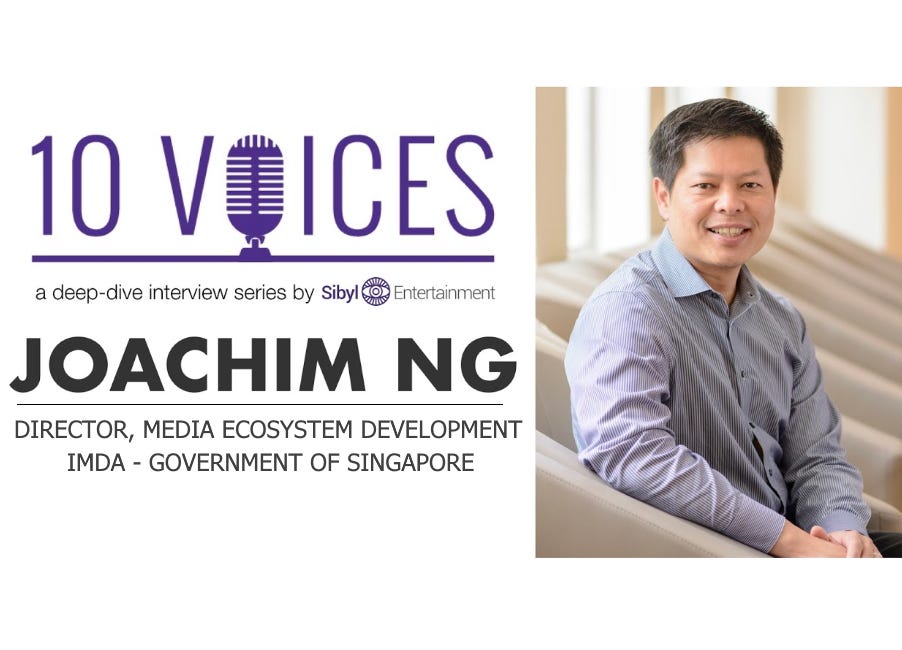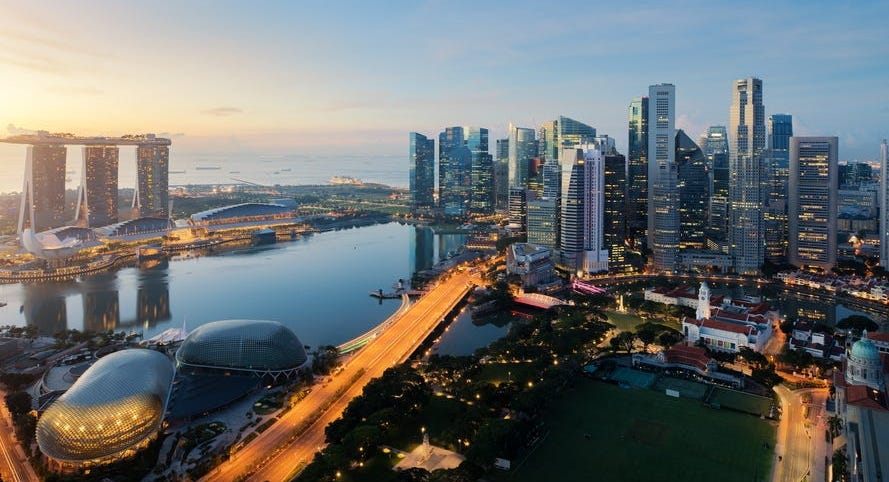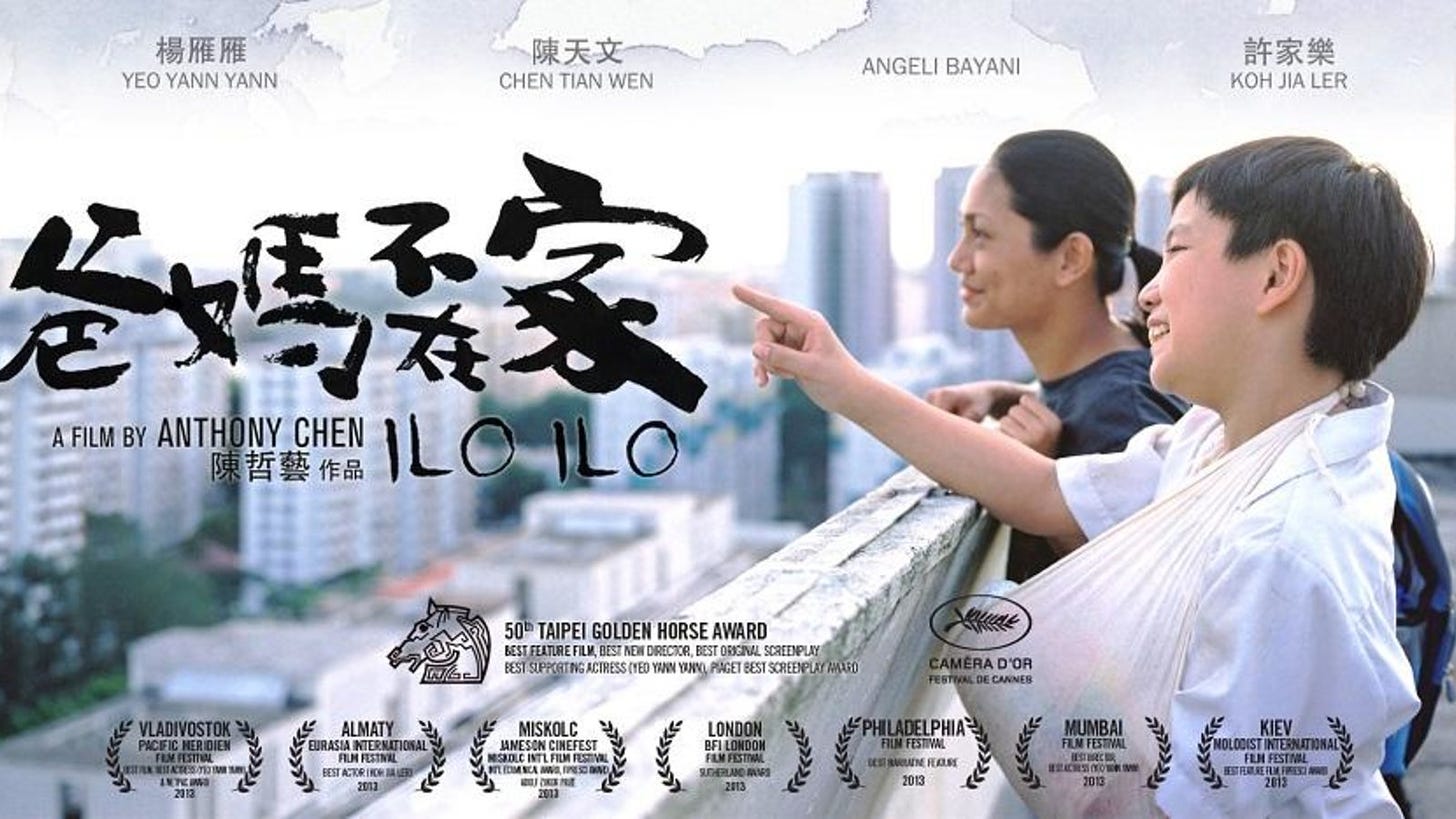10 Voices Interview: Joachim Ng | Leading media industry growth for the Singapore government
Leaders in Asian entertainment weigh in on the past, present, and future.

A nation exporting its culture is at once an advertisement, a projection of soft power, and a status symbol of an ascendant place in the world.
What I’ve learned speaking with leaders in Asian entertainment, is that this doesn’t happen by accident. Behind Korean pop, fashion & film’s now-lofty position, for example, was a deliberate, national-level strategy.
Joachim Ng is the man tasked with developing Singapore’s media industry.
From 2002 until 2011, he was stationed in Silicon Valley, first with the Economic Development Board, and later with the Infocomm Development Authority.
Since returning to Singapore, he’s focused on sustaining the development and growth of the media sector, as Director, Media Ecosystem Development at IMDA. Joachim concurrently helms the Singapore Film Commission (SFC).
Sibyl Entertainment’s Theo Sanders spoke with Joachim to understand Singapore’s strategy for media development, and to hear his broader views on Asian entertainment.

(Theo Sanders): As a starting point, could you explain your own role and that of the Singapore Film Commission?
(Joachim Ng): The SFC was set up in 1998, with a mission to promote and nurture the growth of Singapore’s talent and film-making capabilities. Over the years it’s stayed very true to that mission. I’m the sixth Director of the SFC, and have had the privilege of leading it for the past seven years.
When SFC first started, given the resources it had at the time, it was focused on domestic talent and films. Over the years, we have funded more than 600 projects including feature films, short films, script development, and workshops. A lot of activities have gone into this build up of our film-making and storytelling talent.
How has that mission evolved to where we are today?
2018 was SFC’s 20th anniversary, we took advantage of that to do a review of what we’ve done over the past two decades. We wanted to keep what was working well, but also to add new components we think will be important in the future.
Where we’ve landed is to clarify our mission statement as nurturing generations of filmmakers and storytellers for the nation of Singapore. In a way, that’s an evergreen mission. You need people to tell the nation’s stories, and telling them through the medium of film is one of the most powerful ways to touch and connect.
Film is not just an economic engine or sector for a country, but a cultural product as well. As we nurture the talents, it’s also becoming important to leverage global and regional talent through collaboration or co-production. So, instead of focusing exclusively on talent and stories for our own audiences, we’re casting our net wider. We want our filmmakers, producers, and storytellers - through co-productions, to tell stories from the region for global audiences. That’s our big shift.
I’ve heard that pivot described as moving from “Made in Singapore” to “Made with Singapore.” Is that a fair summary?
You’re correct. For 20 years it was about “Made in Singapore”. We’d film in our HDB flats and our hawker centers, telling our own stories, with our own talent.
The idea of “Made with Singapore” is more collaborative. We realise that the media landscape has shifted and the quality bar has been raised very high. So, if we are to make compelling films, it cannot be only through leveraging Singapore talent. We have to collaborate with the best global talent we can find, and tell the most interesting stories we can find from the region and the world.

(ILO ILO, by Anthony Chen, Singapore’s first Camera d’Or winner at Cannes)
Could you share your journey from initially joining the government to now running the Film Commission?
I was trained as an engineer. After getting my undergraduate and Master’s degrees at Virginia Tech, I returned to Singapore to work at HP for 5 years. But my parents and grandparents were civil servants, so I think in a way it was always my calling to serve the community.
So in 2002 I joined Singapore’s Economic Development Board and later the IDA, based in California. Then I returned to Singapore in 2011 to join the then-Media Development Authority (ed: now IMDA). Each step has given me fresh perspectives on how to best broadly support industries through policy development and formulating programs.
When I returned to Singapore, I was considering departing the public service to try something else, but an opportunity unexpectedly arose, and I was recruited into the MDA. The inner workings of the media industry were very new to me, and I saw that as a chance to learn something brand new. Before, in technology I often met with extremely intelligent people, whereas in media I’m meeting extremely creative and passionate people, which is a very different type of experience.
Makes sense. Film financing alone is already a very different beast from the rest of the entertainment industry. I imagine there was a lot to learn.
Technology tends to be more deterministic in terms of business models. Whereas in media, there is really no formula to predict commercial success. Or even whether a film or piece of content will connect with a certain audience.
So I find that both a maddening problem, but also one that gives you the freshness and unexpectedness which is exciting.

The changing industry landscape & social media
When you talk about nurturing talent, there’s a broad ecosystem in film making. Which parts are you most referring to?
I would say the storytellers are very important, and so a lot of attention is given to writers and directors. They typically get the limelight! But producers are also very important.
In the region, we tend to think of producers as the people who assemble talent, and work on the logistics of locations and equipment. They’re project managers. But if you look at the Western world, the best producers are also creative. They’re looking at the scripts and giving very creative ideas of how to realise the story based on resources and budget. That’s the kind of talent we want to hone too, creative producers who have a strong influence on the projects and stories from the region.
To what extent has social media and streaming provided an alternative model for those looking to build a career in media?
Five or six years ago, we saw a new generation of storytellers emerge. Online creators and YouTubers who behaved very differently from traditional filmmakers or television production people.
While we anticipated these new types of content creators would have a great influence in the world, the (final) impact is still unclear to me.
The platform and format might be different, but at the heart of it is still whether that person has something interesting to say. Whether or not they have interesting ways of telling stories that can connect with audiences. While the power of a digital platform like YouTube opens a lot of opportunities, I still believe talent is talent. Whether you are trying to create a two-hour movie or a two-minute piece of content, talent is the common thread.
I agree. At least so far as making a career out of storytelling is concerned, that’s also the risk of YouTube. There is no up-front filter.
What happened a few years ago is the barriers came down. Because it was so much easier to make digital content, a lot of people rushed in (to streaming), but many quickly discovered that you need to be talented enough to stay in that industry too.
We’ve seen consolidation now. Some people who rushed in early, have now realised perhaps they weren’t meant to continue doing this and dropped out. The really talented ones continue. I would say that the person who can create great content online - given the right opportunity - can also create great content in more traditional form. Many would, given the chance, so I think it all converges eventually.
One hypothesis I’ve heard is that we’re entering the “Age of the Artist.” Where the barriers between creators and fans are evaporating, where the power of the traditional gatekeepers is waning.
From my perspective, there is some tension between traditional media and online creators. Film and television programs have been made in a certain way for a long time, and now they are confronted by upstart YouTubers who don’t necessarily conform to the old rules of doing business or making content.
In a way, that’s very liberating because content can be made in exciting new ways, and reach audiences much faster. The value chain hasn’t actually changed that much, but it’s become more compressed and efficient.
Online creators have to multitask in new ways. They have to be good at social media, at creating content, at being the host, and often, their own cameraman.
But I think that if you want to make truly epic content right, the next Parasite, say, it’s still the professionals. It’s an orchestra of professionals coming together to realise something epic. And ultimately audiences vote with their eyeballs. They’re always looking for quality content, things which will surprise them, and great stories.

(Singapore influencer Xiaxue (C) 8 Days)
Singapore’s big-picture media industry strategy
There’s been a liberalisation of the media ecosystem in Singapore. Starting with a state monopoly, then a duopoly with SPH getting its broadcasting license (ed: in 2001), to now all the OTT players entering the market.Is that competition leading to better storytelling?
My view, having attended all sorts of content markets and film festivals over the past seven years, is that there’s way too much content out there. When I walk through these shows like Hong Kong Filmmart and MIPCOM, and see thousands of films and animations, I always ask myself who’s actually going to watch all this stuff?
I don’t know how many titles are on Netflix. Let’s say it’s 100,000 films. I’d guess only 10% are actually being watched and the rest are just kind of there. Audiences are getting more sophisticated and they look for quality.
The bar keeps getting raised higher. Korean dramas over the past decade have raised their standards incredibly high. That’s now the standard that all other Asian scripted dramas are being held up against.
While there’s many more opportunities with OTT now for stories to be realised and produced, that doesn’t mean every piece of content will find an audience.
Which parts of the ecosystem are in place, today, for Singapore to produce films to these quality expectations?
Certain places are film hubs: Hollywood, Bollywood, Korea, and even China is emerging as a content giant. Singapore is very different. We’re small and compact, with limited resources. So we have to be realistic and practical about what our role in film really is.
It’s important for our culture, and who we are as a nation and as a people, that Singapore has its own filmmakers and storytellers. But if you talk about the global media value chain, and where Singapore should position itself, I think then it’s a very different calculation.
Some of our filmmakers have gone on to win awards in Cannes and at Sundance. We do have our peaks of excellence when it comes to some of our filmmakers, but as a whole we can only make 10 to 15 films per year. That’s a tiny number compared to the hundreds of films produced each year in India, and thousands in China.
Objectively, we’ve come to the conclusion that Singapore is not a viable film production hub. The industry is just too small a part of the economy, and it isn’t the cheapest place to produce.
So it’s more about positioning Singapore as a kind of “headquarters” for film production, rather than doing the grunt work here?
We can position Singapore as a place where we can package films, pool talent, do distribution, rights management, and financing. We are networked into the region to understand the tastes of the markets around us. We can identify some of the best stories in the region, and help these get realized in film. That’s something Singaporean producers and filmmakers have already started doing.
We are a business-friendly place, where the rule of law is transparent. Like in technology, the factories might not be in Singapore, but the R&D and the headquarters will be based here. It’s the same for the media industry. The giants like Facebook, Google, YouTube, Warner Media, HBO Asia, and Netflix are all headquartered here. And they’re looking to leverage Singapore’s presence in the region.

(Mapletree Business City, home to IMDA and many media giants)
As for the cultural importance of having local storytellers, is Singapore missing some of the grit and messiness of daily life that breed creativity? Is that fair?
When I was just starting out, a well-known filmmaker told me it’s hard for Singapore to become a powerhouse in film because life is too good here. He told me you need a certain level of angst and chaos in the country to bring out that creativity.
I thought about that, and wasn’t sure if I agreed completely. But now I’ve had a chance to travel, and meet filmmakers and film commissions in the region. If I compare their scripts with the ones created by Singaporeans, I do see tremendous diversity. It’s not just the physical diversity - we don’t have villages and farms in Singapore - but also the socioeconomic diversity where you have extreme poverty and class divisions.
When you have extreme repression for example, the types of stories that come out are incredibly diverse and rich. We’re very multicultural, but in the past two or three decades people have reached a certain level of affluence. There’s a certain orderliness that’s quite uniform. So in a way, I’ll say “yes it’s fair”.
But I think that Southeast Asia has incredible potential, and that Singapore’s growth in films is not limited to our borders if we go out and be part of that broader ecosystem.
I went through a phase of reading early Russian literature, writers like Dostoevsky and Pushkin. It struck me that their stories mirrored that country’s psyche. Everything was dark, pessimistic, and usually ended miserably. If you accept that reasoning, maybe the reason the Thais are so good at horror films is because they're deeply spiritual people. So in that vein, is there a “Singapore psyche” that defines the stories we tell?
I’d say if you look at some of the films like Jack Neo’s Ah Boys to Men or Wet Season, there is a longing for identity in these films. Who are we? What do we stand for?
Singapore is a young nation that emerged from a difficult period with the separation from Malaysia. Although if we look at Singapore today we are by most measures very successful: be it our educational levels, mortality rates, wealth, and all that, we’re always a bit anxious and paranoid. There’s still that anxiety and uncertainty of “are we secure?” and “what is our future?”

(Jack Neo’s ‘Ah Boys to Men’)
Gin Kai Chan spoke to me about economic growth preceding cultural growth in places like Japan and Korea. Singapore’s economy is strong, but are we near an inflection point where civic life and culture start becoming a more important part of the mix?
The 10 Voices interview with Gin Kai Chan, film producer & financier, is here.
Coming from 20 years of public service, mostly on the economic side of things, I’d say from the government’s point of view the economy will continue to be the prime focus. Because we have a belief system that if you don’t have a strong economy, nothing else matters or can be achieved. Your social system, your culture, comes from a strong economy. I don’t think that’s going to change.
That's very deeply ingrained in our government’s psyche, perhaps even our national psyche. You need to have strong savings for rainy days. Your finances need to be strong. And only then, after all that, are other things possible.
So the practical side of me feels it’s not clear there’ll be an inflection point where if Singapore has achieved a certain level of affluence and prosperity, the focus will majorly pivot to the arts. I think the more affluent we are, and the stronger the economy is, the more we are able to focus resources on the luxury side of things like culture and film.
Where Asian entertainment is headed
What do you make of Korea exporting its culture in so many ways across film, television, pop music, and fashion?
The Korean example is very unique. Scholars will probably study this example for decades to come. How did a country of 55 million people create a wave on so many fronts like you mentioned? This is something unique when you think about it, because China or America or Japan are not just big economically, but in terms of people too, so they make sense.
So if the Koreans can do it, why can’t Indonesia with 300 million people do it? Or even countries like Myanmar or Vietnam with 50 million?
I would say there’s some differences. I think Korean culture is very disciplined and driven. Japan and China are too. But they also have a system of government which is extremely supportive to orchestrate that. What’s perhaps not as well known is that the Korean government has been very deliberately investing in media for decades.
They paid their dues in the early years when Korean content wasn’t very good, and not consumed outside of Korea. They protected their domestic markets and found ways to invest in talent and in the industry, both in Japan post-World War II, and now in post-1980 Korea. So today they reap the benefit.

(Korean boy band BTS, currently top of the charts… in America (c) BTS)
I’m not sure that’s entirely repeatable in Southeast Asia.
The different Southeast Asian governments may not place the same importance on the creative industries. Therefore in some countries the media industry is essentially left on its own, driven by the private sector.
In Singapore we’re very fortunate: with affluence comes resources. The IMDA has the ability to support our media companies and talents more so than in neighboring countries. That has also skewed development in certain ways too, in that we’re a lot more international. Our media talents are better networked and are aware of how to interact with top-tier film festivals and regional markets, for example. That same opportunity is not often present in many Southeast Asian countries.
It seems so much is happening with Asian Entertainment on the global stage. Not just in film and television, but in areas like music too. What’s going on here? Is this a fleeting Renaissance where we happen to have a lot of special talents around all at the same time, or something more systemic?
Some say this is the Asian century. With the rise of China and India as two of the biggest economies and with the biggest populations and rising standards of living. Southeast Asia is the same. We’re industrialising and urbanising, while disposable income is rising.
All these hundreds of millions of people entering the middle class are consumers of content and media as well. That’s a tremendous opportunity. And now with the platforms where people consume content being democratised, that’s why Asian content has really come into the limelight.
Of course, the Western companies are seeing Asia from that light too. Whether it’s new audiences to distribute their films to, or whether it’s to create content for Asians by Asians. That’s the reason companies like Netflix and Disney are investing heavily in Asia: everyone wants a piece of the pie. The macroeconomics are shifting in Asia’s favor.
If you look ahead to the next couple of years, what would you rate as your top priority to succeed in the “Made With Singapore” strategy?
For the media sector, the top priority for the IMDA is to develop and groom creative producers. We are looking for talents who are more international… who are willing to go out into the region and build bridges to these larger markets and to connect with talent. Producers who can drive co-productions, and create quality content that is “Made with Singapore”.
This isn’t just a one or two year priority, it’s a decade-long project.
But we’ve started, and I think we’re one of the earliest countries to recognise that this is going to be important. Co-production and collaboration are going to be important parts of the growth of the industry overall. We can play a leading role in that for the region.
Let’s talk about what’s already been accomplished. If I’m a World Tomorrow reader, and I wanted to get a sense how far Singapore or Southeast Asia has come, which movies would you suggest I go watch to give me a good representation of the current “state of the art” of film-making here?
That is actually a very difficult question, to pick one or two films that someone outside of our region could watch and say, “ok, so this is the stage of progress,”
I’m trying to think of a film that’s both critically acclaimed by global audiences and at festivals, yet also connects to everyday life in Southeast Asia.
If you were to limit it to Singapore, then maybe Anthony Chen’s Wet Season. It’s a mature, heartfelt, and authentic piece of storytelling. It’s a really well put together story that can sit alongside many top-tier films in festivals.

(Anthony Chen’s Wet Season)
If you look at commercial films, then Crazy Rich Asians. It’s a Hollywood film, by an American director, but it utilised 300 Singapore talents. But that is the level of scale and professionalism we can offer in terms of storytelling.
These two films are poles apart. One very commercially driven, with Western influence but of course infused with Singapore talent both on-screen and off-screen. And then the other one, a heartfelt independent film.
Thank you, Joachim.
Receive the “10 Voices” interviews to your email inbox.
We hope you’re enjoying these interviews! To get them all, just look around for the green “Subscribe” button and enter your email address. Or visit the main page.



